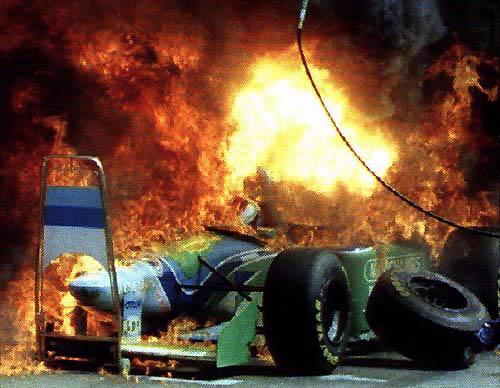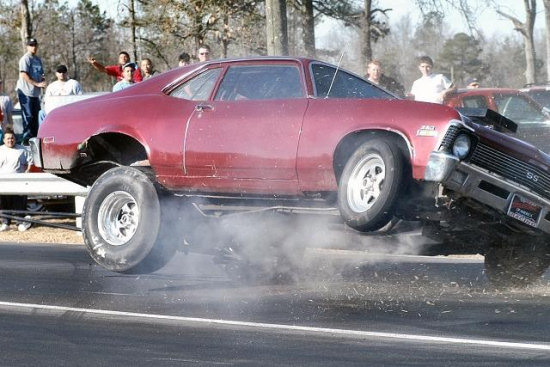Source(Google.com.pk)
Race Car Crashes Biography
The Formula 1 world championship is governed and owned by a world body of motor racing based in France, called the International Automobile Federation, or FIA. The commercial rights to F1 are leased by the FIA to a British man named Bernie Ecclestone. NASCAR is owned by the France family - as opposed to the country - although it too it is a private racing series.
NASCAR racing cars resemble the cars that you drive on the highway, your basic road cars. Formula 1 cars look like insects - you know, they have long snouts, wings, the wheels are entirely outside the body like an insect's legs and the drivers are visible in the middle of all this like the bug's eye.
NASCAR has the reputation, fairly or unfairly, of appealing to a bunch of yokels, whereas Formula 1, fairly or unfairly, has the reputation for appealing to intellectuals - except for the fans of the former driver, Michael Schumacher. Formula 1 fans are supposed to be motor racing purists who take pleasure in watching cars perform the perfect lap on winding circuits, while NASCAR fans are supposed to be interested in watching cars crash as they go around in circles in a tightly knit pack.
Formula 1 is to NASCAR what basketball is to soccer, like the difference in the goals in those two sports. There is very little passing on track in F1, but when a car finally does pass another the world celebrates - as with the rare goals in soccer. In NASCAR, cars pass each other all the time, like goals scored in basketball.Due to the inherently dangerous nature of auto racing, many individuals, including drivers, crew members, officials and spectators, have been killed in crashes related to the sport, in races, in qualifying, in practice or in private testing sessions. Deaths among racers and spectators were numerous in the early years of racing. However advances in safety technology, and specifications designed by sanctioning bodies to limit speeds, have reduced deaths in recent years. Spectacular accidents have often spurred increased safety measures and even rules changes. The worst motorsports accident was Pierre Levegh's 1955 crash at Le Mans that killed him and around 80 spectators with over 100 being injured.
The five tracks with the most competitor fatalities
Indianapolis Motor Speedway
Nürburgring
Monza
Daytona International Speedway
Le Mans
This is a list alphabetically sorted, and structured after the kind of competition, of the more notable drivers, excluding motorcycle riders. In addition, several famous racing drivers have been killed in public road crashes; see List of people who died in road accidents.
JAN BROGAN: Although I never watch car racing, my husband and I happened to be flipping between stations at exactly the moment that the Indy race cars crashed on the Nascar track in Las Vegas last week.
Drawn into the drama, we kept flipping back from the Patriots game to the race track to find out what was going on. We were stunned, and even shaken, when it was announced that veteran driver Dan Wheldon had died.
As the cars took their laps around the racetrack, a solemn memorial, and the camera panned to the spectators, standing, head bowed, with many of the women crying, I had an ungenerous thought. Wasn't this why people watched car racing - because a crash was always possible? Wasn't it a little like going to the Coliseum, but crying when someone got fed to the lions?
And now, as they talk about making IndyCar racing safer by not racing on small oval tracks, I wonder could they ever really make it completely risk free? And if they could, what would that do to car racing?










Race Car Crashes Biography
The Formula 1 world championship is governed and owned by a world body of motor racing based in France, called the International Automobile Federation, or FIA. The commercial rights to F1 are leased by the FIA to a British man named Bernie Ecclestone. NASCAR is owned by the France family - as opposed to the country - although it too it is a private racing series.
NASCAR racing cars resemble the cars that you drive on the highway, your basic road cars. Formula 1 cars look like insects - you know, they have long snouts, wings, the wheels are entirely outside the body like an insect's legs and the drivers are visible in the middle of all this like the bug's eye.
NASCAR has the reputation, fairly or unfairly, of appealing to a bunch of yokels, whereas Formula 1, fairly or unfairly, has the reputation for appealing to intellectuals - except for the fans of the former driver, Michael Schumacher. Formula 1 fans are supposed to be motor racing purists who take pleasure in watching cars perform the perfect lap on winding circuits, while NASCAR fans are supposed to be interested in watching cars crash as they go around in circles in a tightly knit pack.
Formula 1 is to NASCAR what basketball is to soccer, like the difference in the goals in those two sports. There is very little passing on track in F1, but when a car finally does pass another the world celebrates - as with the rare goals in soccer. In NASCAR, cars pass each other all the time, like goals scored in basketball.Due to the inherently dangerous nature of auto racing, many individuals, including drivers, crew members, officials and spectators, have been killed in crashes related to the sport, in races, in qualifying, in practice or in private testing sessions. Deaths among racers and spectators were numerous in the early years of racing. However advances in safety technology, and specifications designed by sanctioning bodies to limit speeds, have reduced deaths in recent years. Spectacular accidents have often spurred increased safety measures and even rules changes. The worst motorsports accident was Pierre Levegh's 1955 crash at Le Mans that killed him and around 80 spectators with over 100 being injured.
The five tracks with the most competitor fatalities
Indianapolis Motor Speedway
Nürburgring
Monza
Daytona International Speedway
Le Mans
This is a list alphabetically sorted, and structured after the kind of competition, of the more notable drivers, excluding motorcycle riders. In addition, several famous racing drivers have been killed in public road crashes; see List of people who died in road accidents.
JAN BROGAN: Although I never watch car racing, my husband and I happened to be flipping between stations at exactly the moment that the Indy race cars crashed on the Nascar track in Las Vegas last week.
Drawn into the drama, we kept flipping back from the Patriots game to the race track to find out what was going on. We were stunned, and even shaken, when it was announced that veteran driver Dan Wheldon had died.
As the cars took their laps around the racetrack, a solemn memorial, and the camera panned to the spectators, standing, head bowed, with many of the women crying, I had an ungenerous thought. Wasn't this why people watched car racing - because a crash was always possible? Wasn't it a little like going to the Coliseum, but crying when someone got fed to the lions?
And now, as they talk about making IndyCar racing safer by not racing on small oval tracks, I wonder could they ever really make it completely risk free? And if they could, what would that do to car racing?
Race Car Crashes

Race Car Crashes

Race Car Crashes

Race Car Crashes

Race Car Crashes

Race Car Crashes

Race Car Crashes

Race Car Crashes

Race Car Crashes

Race Car Crashes

Race Car Crashes
Great knowledge, do anyone mind merely reference back to it brandon auto repair
ReplyDelete